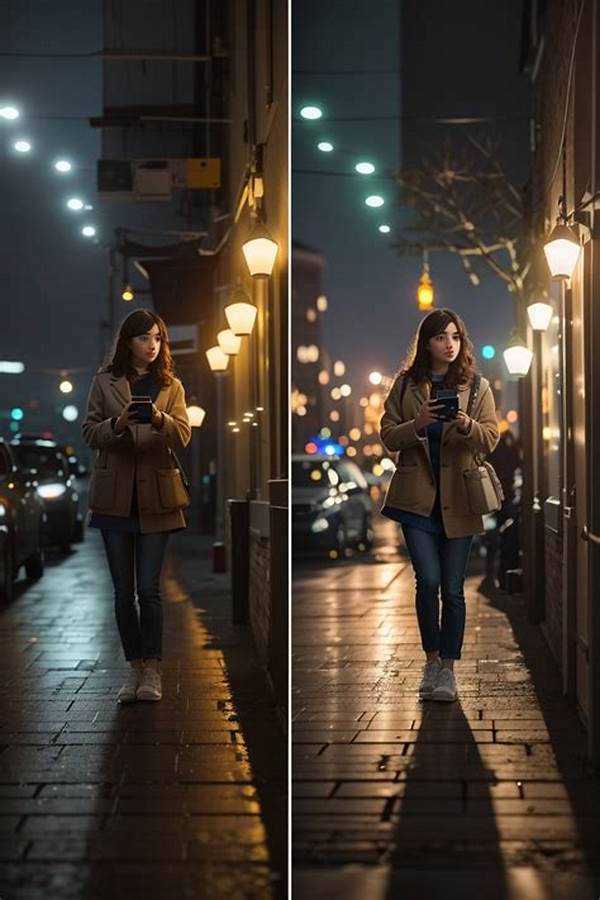Hey there, fellow photography enthusiasts! Have you ever tried snapping a breathtaking night cityscape or a candlelit dinner, only to end up with a noise-filled mess? You’re not alone! Low-light photography with smartphones can be tricky, but don’t worry—I’ve got your back. In this guide, we’ll dive into some practical smartphone low-light photography tips that will help you shine, even when the lights are dim.
Read Now : Framing Contributes To Photo Aesthetics
Mastering Your Camera Settings
Understanding your smartphone’s camera settings can make all the difference when it comes to low-light photography. First up, try switching to manual mode if your phone offers it. This will give you control over crucial settings like ISO and shutter speed. Lower ISO can reduce noise, while a slower shutter speed lets in more light—perfect for those twilight shots. Don’t forget to keep your phone stable, either by using a tripod or bracing your hands against a solid surface. With these smartphone low-light photography tips, you’ll capture those details like a pro!
Now, let’s talk about flash. While it can flood a shot with light, it often washes out colors and flattens your images. Instead, look for ambient light sources, like street lamps or neon signs, to add depth and mood to your pictures. Lastly, tap on the screen to adjust the focus and exposure before taking the shot. This tip alone can drastically improve the clarity of your low-light photos.
Practical Tips for Better Low-light Shots
1. Use Night Mode: Most smartphones come with a built-in night mode. Make the most of it for crisp, clear captures. That’s one of the easiest smartphone low-light photography tips!
2. Keep it Steady: Avoid blurry images by steadying your phone against a flat surface or utilizing a tripod.
3. Experiment with Angles: Play around with different perspectives to see how the light interacts with your subject differently.
4. Edit Wisely: Use editing apps to enhance your photos. Tweak exposure and sharpness for better results.
5. Avoid Zooming: Digital zoom can ruin the image quality. If possible, move closer to your subject instead.
The Role of Composition in Low-light Photography
Composition plays a significant role in elevating your low-light photos. While it might be tempting to capture everything in one frame, focusing on a single subject or source of light can create a more striking image. Use the rule of thirds to guide your composition, positioning your main subject slightly off-center. This can add balance and interest to your photos. By integrating smartphone low-light photography tips into every shot, you’ll become more adept at capturing photos that tell a story.
Speaking of stories, think about what mood you’re trying to convey. Low light often lends itself well to dramatic and moody shots, so lean into that by highlighting shadows or using negative space strategically. Remember, what you leave out of the frame is just as important as what you include. Details should be intentionally chosen to complement the overall atmosphere you’re trying to create.
Smartphone Low-light Photography Tips Explained
1. Night Mode Usage: Experience the magic of technology designed to enhance low light captures.
2. Stability Matters: Keep your device ultra-steady to avoid unwanted blur.
3. Lighting Sources: Use available light for a unique touch. Seek out ambient rather than relying solely on your phone’s flash.
4. Angles & Perspectives: Varying your perspective can change the dynamics of light and shadow in your shot.
Read Now : Tips For Stress-free Portrait Sessions
5. Edit to Perfection: Post-production edits can transform a good photo into a great one. Focus on exposure, contrast, and sharpness.
6. Natural Zoom: Physical closeness beats digital zoom every time.
7. Explore HDR Mode: Sometimes HDR (High Dynamic Range) mode can balance uneven light sources effectively in low-light settings.
8. Adjust White Balance: Play around to make colors pop in low-light.
9. Monitor ISO Levels: Balance the ISO so you’re managing light and noise wisely.
10. Manual Settings: Dive into manual settings if your camera allows; further control can lead to more nuanced outcomes.
Focus on Small Details
So, let’s chat more about nailing small details when shooting in low light. Attention to detail can separate your photos from the sea of nighttime selfies that flood social media. Whether it’s capturing the glint of moonlit water or the texture of leaves under street lamps, small details can become the focal point. Our smartphone low-light photography tips emphasize finding these moments that tell unique stories.
Another trick? Get close. Embrace the macro capabilities of your smartphone. Capture close-up shots of an eye, a flame, or even raindrops on a window. These intimate glimpses often add a mesmerizing quality to your photos. Remember to play around with the focus to keep these details sharp against a softer background, ensuring that what’s essential remains at the forefront.
Wrapping Up: Embrace the Shadows
Hey, mate, here’s the real deal—darkness ain’t all that bad! Shadows can be your best friend when it comes to adding drama and allure to your shots. Embrace it! Instead of fearing the lack of light, harness it. Our trusty smartphone low-light photography tips aren’t just about navigating challenges; they’re about finding new opportunities in those poorly lit scenarios.
In those low-lit environments, experimentation is your best buddy. So, try all kinds of angles, move around your subject, and let the light (or lack thereof) guide you. Be fearless, test boundaries, and most importantly, have loads of fun while you’re at it. Remember, it’s not just about capturing an image; it’s crafting a narrative!



